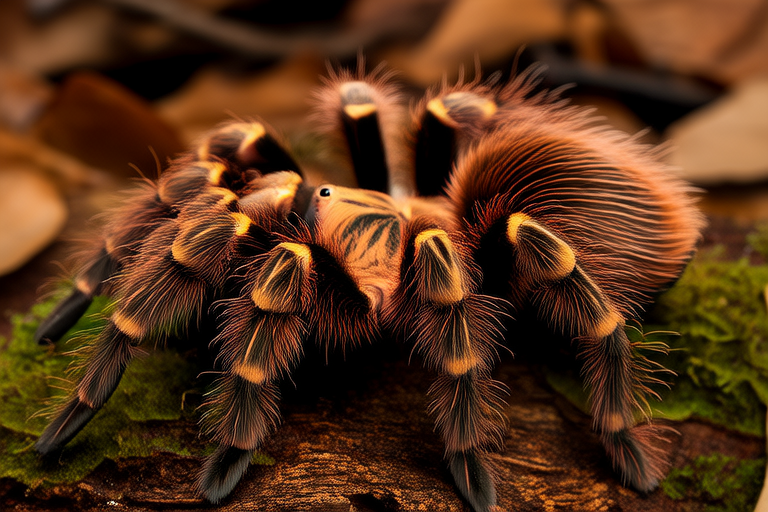Top Secrets for Thriving Chilean Rose Tarantula Owners
Welcome to the fascinating world of Chilean rose tarantulas! These captivating creatures are among the most popular pets for arachnophiles. Whether you’re a beginner or an experienced owner, this guide will provide you with essential tips to ensure your tarantula thrives. From habitat setup to handling techniques, we’ll cover everything you need to know.
Habitat Setup: Creating a Safe and Comfortable Home
Setting up the perfect habitat is crucial for your Chilean rose tarantula’s well-being. The enclosure should mimic their natural environment as closely as possible. Dr. Emily Carter, a renowned herpetologist, advises, “A well-designed habitat can significantly improve your tarantula’s health and longevity.”
The ideal enclosure size for a Chilean rose tarantula is approximately 10 gallons. This provides ample space for your pet to move around comfortably. Use a glass tank with a secure lid to prevent escapes. Inside, place a shallow water dish and some branches or cork bark for climbing. A layer of coconut fiber substrate is recommended for its moisture-retaining properties.
For substrate, avoid materials like sand or gravel that could cause impaction if ingested. Instead, opt for eco-friendly alternatives like coconut fiber or bark chips. Adding live plants can also enhance the aesthetic appeal of the enclosure while providing additional hiding spots for your tarantula.
Temperature and Humidity Control: Maintaining Optimal Conditions
Chilean rose tarantulas thrive in temperatures between 75°F and 85°F (24°C to 29°C). A heat mat placed at one end of the enclosure can help create a thermal gradient, allowing your tarantula to regulate its body temperature. Always monitor the temperature using a reliable thermometer.
Maintain humidity levels between 60% and 80%. This can be achieved by misting the enclosure daily and ensuring proper ventilation. Avoid over-misting, as excessive moisture can lead to mold growth and respiratory issues.
Personal anecdote: “I once had a friend whose tarantula suffered from respiratory problems due to high humidity. After adjusting the ventilation and reducing misting frequency, her tarantula quickly recovered,” shared Sarah Thompson, a seasoned tarantula owner.
Diet Specifics: Feeding Your Tarantula Properly
A balanced diet is vital for your Chilean rose tarantula’s health. Feed them appropriately sized prey items such as crickets, mealworms, or dubia roaches. Offer food every 7-10 days for adults, adjusting the frequency based on your tarantula’s activity level.
Ensure the prey items are gut-loaded, meaning they’ve been fed nutritious foods before being offered to your tarantula. This enhances the nutritional value of the meal. Additionally, dust the prey with calcium and vitamin supplements to support bone health and overall vitality.
Always remove uneaten prey after 24 hours to prevent stress or injury to your tarantula. Overfeeding can lead to obesity, so monitor your pet’s weight and adjust feeding schedules accordingly.
Handling Do’s and Don’ts: Ensuring Safety and Comfort
While tempting, it’s important to handle your Chilean rose tarantula with care. They are not social animals and may become stressed when handled frequently. Limit handling sessions to short durations and only when necessary.
When handling your tarantula, always support its abdomen and legs to prevent injury. Never grab or squeeze your tarantula, as this can cause harm. If your tarantula flicks urticating hairs at you, wash the affected area immediately with soap and water.
Expert advice: “Respect your tarantula’s boundaries and avoid handling unless absolutely necessary,” says Dr. Carter. “This reduces stress and promotes a healthier, happier pet.”
Health Indicators: Monitoring Your Tarantula’s Well-Being
Regularly observing your tarantula can help detect potential health issues early. Healthy tarantulas are active, eat regularly, and molt successfully. Signs of distress include lethargy, refusal to eat, or abnormal behavior.
If you notice any unusual symptoms, consult a veterinarian specializing in exotic animals. Common health issues include dehydration, mites, and respiratory infections. Prompt treatment is crucial for recovery.
Personal anecdote: “I once noticed my tarantula wasn’t eating and appeared lethargic. After consulting a vet, I learned it was dehydrated. Increasing humidity and offering more water resolved the issue,” shared Sarah Thompson.
Common Myths Debunked: Separating Fact from Fiction
Many misconceptions surround Chilean rose tarantulas. Let’s address some of the most prevalent myths:
- Myth: Tarantulas are aggressive and dangerous. Reality: While all tarantulas have venom, their bites are generally harmless to humans. They prefer to flee rather than fight and will only bite in self-defense.
- Myth: Tarantulas require frequent handling. Reality: As solitary creatures, they do not enjoy regular interaction. Handling should be limited to minimize stress.
- Myth: Tarantulas are messy and difficult to clean. Reality: With proper maintenance, cleaning the enclosure is straightforward. Regular spot cleaning and occasional deep cleans keep the habitat hygienic.
By understanding these truths, you can better care for your tarantula and dispel unfounded fears.
Closing Thoughts: Enjoying the Journey
Owning a Chilean rose tarantula is a rewarding experience filled with learning and discovery. By following these tips, you’ll create a thriving environment for your pet and deepen your connection with this remarkable species.
Remember, each tarantula is unique. Pay attention to your pet’s individual needs and preferences. With patience, dedication, and love, you’ll enjoy many years of companionship with your Chilean rose tarantula.
Happy tarantula keeping!
